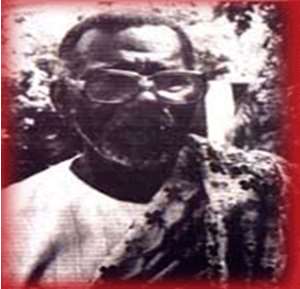
A look at the dailies reminds me of a retired dairy farmer who told me, years ago, that long before websites and complications like common directional policies by government, the toast of the people was reading about patriotic pieces in the few news prints available.
It is against this background I write on a historic icon, Nii Amon Kotei, designer of the Coat of Arms of Ghana.
Nii Amon Kotei, a Ghanaian artist (sculpture, painter and musician) and surveyor was one of Ghana's finest artists.
Kotei, was born on May 24, 1915, at La, near Accra, and belonged to the Ga tribe and trained as a surveyor.
He studied under a scholarship at Achimota School and later received a scholarship to study art at the London School of Printing and Graphic Art from 1949-1952.
He also fought for the Royal West African Frontier Force during World War II and also worked in the Cartographic Division of the Army. He drew maps and plans for use by soldiers on the war front. He also thought in Achimota School.
As Independence Day drew near, the need for a coat of arms distinct from that of the imperial power, Great Britain became acutely felt. To give a distinctive local flavor to the work, experienced Amon Kotei was asked to put up a sketch for consideration.
For his motives, Mr. Amon Kotei had the elephant and palm tree. After months of hard work Mr. Amon Kotei, finally completed the drawing and after comparing it with other Coats of Arms, he was convinced that it was one of the best, a view shared by Cpt. Hamilton, the British officer who liaised between him and the Osu, Castle. It was approved without hesitation.
The Ghana Coat of Arms, found on all government official letter heads, is composed of a shield, divided into four quarters by a green St. George's Cross, rimmed with gold.
The Coat of Arms produced by Amon Kotei has this composition
Crossed Linguists' Staff And Ceremonial Sword On A Blue Background
This is positioned at the top left-hand quarter represents local administration
A Heraldic Castle On A Heraldic Sea With A Light Background.
Also positioned at the top right-hand quarter representing national government.
A Cocoa Tree is at the Bottom left-hand quarter depicting the agricultural wealth of the country
A Mine Shaft located at the dottom right-hand quarter.It represents the mineral wealth of the country
A Gold Lion is also positioned at the centre of the Green St George's Cross showing the continuing link between Ghana and the Commonwealth.
Black Five-Pointed Star Rimmed with Gold Standing on the Wreath of Red, Gold And Green Colours
With easy identification it's on top of the shield meaning the lone star of African Freedom.
Two Eagles, Around Each Of Whose Neck Hangs A Black Star Suspended From A Ribbon Of Ghana's Colours - Red, Gold And Green
This can be found supporting the shield on the left and right hand side. It signifies a protector with strength, very clear and attentive eyes keeping watch over the country.
The motto FREEDOM AND JUSTICE is found under the shield. It represents national aspirations.
In recent times critics have raised concerns about the use of a castle in Ghana's national emblem - the Coat of Arms saying it may no longer be tenable, due to the fact that the Osu Castle is no longer the seat of Government.
However it has not been changed and remains what was originally produced by Amon Kotei.
Amon Kotei died on October 17, 2011. He received several awards including the State Honour of Grand Medal, Civil Division, Coat of Arms Design that was presented to him on Friday, March 7, 1997 by then president Jerry John Rawlings.
If you should forget anything about this piece it should not be the line below.
The Ghanaian icon, Nii Amon Kotei was a distinguished artist who designed the National Coat of Arms on March 4, 1957.
The Ghana Coat of Arms is found on all official government letterheads. It symbolises government sanction and it is found at important Government places like the Osu Castle, the Courts and other government offices.
References
http://www.ghana.gov.gh/index.php/about-ghana/coat-of-arms
http://www.blackstargroupinc.com/1210/index.php?option=com_content&view=article&id=47&Itemid=57
Kwaku Boakye Karikari
Development Journalist
Follow on Facebook @ Qwequ Yiadom
Twitter @KAKBOAKYE
Instagram @ kwaqukarik
 2015-02-10 122104
2015-02-10 122104




 We’ll no longer tolerate your empty, unwarranted attacks – TUC blasts Prof Adei
We’ll no longer tolerate your empty, unwarranted attacks – TUC blasts Prof Adei
 Bawumia donates GHc200,000 to support Madina fire victims
Bawumia donates GHc200,000 to support Madina fire victims
 IMF to disburse US$360million third tranche to Ghana without creditors MoU
IMF to disburse US$360million third tranche to Ghana without creditors MoU
 Truck owner share insights into train collision incident
Truck owner share insights into train collision incident
 Paramount chief of Bassare Traditional Area passes on
Paramount chief of Bassare Traditional Area passes on
 Two teachers in court over alleged illegal possession of BECE papers
Two teachers in court over alleged illegal possession of BECE papers
 Sunyani: Victim allegedly shot by traditional warriors appeals for justice
Sunyani: Victim allegedly shot by traditional warriors appeals for justice
 Mahama vows to scrap teacher licensure exams, review Free SHS policy
Mahama vows to scrap teacher licensure exams, review Free SHS policy
 Government will replace burnt Madina shops with a new three-story, 120-store fac...
Government will replace burnt Madina shops with a new three-story, 120-store fac...
